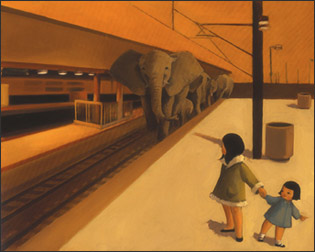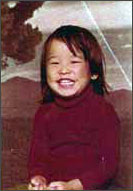|
Your donation is 100% tax deductible
|
 Seonna Hong is a working artist in both the fine art and animation communities. Her exhibitions routinely sell-out (most recently at sixspace, Los Angeles and Roq la Rue, Seattle), making her one of the most sought-after artists in the country. Her upcoming solo exhibition at 5BE Gallery in New York solidifies her place in the contemporary art world. Seonna Hong is a working artist in both the fine art and animation communities. Her exhibitions routinely sell-out (most recently at sixspace, Los Angeles and Roq la Rue, Seattle), making her one of the most sought-after artists in the country. Her upcoming solo exhibition at 5BE Gallery in New York solidifies her place in the contemporary art world.
 This year she was nominated for an Annie Award for her background work on My Life As a Teenage Robot, the newly acclaimed Nickelodeon show. Other animation projects have included doing background paintings for Gary Baseman's Emmy Award Winning television show Teacher's Pet and Powerpuff Girls: the Movie for Cartoon Network. Hong has been included in publications such as Lemonade Magazine, Portland Mercury (cover), Seattle Post Intelligencer, and Aphid Magazine (cover) as well as the books The Truth Show, Beatsville, and Sci-Fi Western. This year she was nominated for an Annie Award for her background work on My Life As a Teenage Robot, the newly acclaimed Nickelodeon show. Other animation projects have included doing background paintings for Gary Baseman's Emmy Award Winning television show Teacher's Pet and Powerpuff Girls: the Movie for Cartoon Network. Hong has been included in publications such as Lemonade Magazine, Portland Mercury (cover), Seattle Post Intelligencer, and Aphid Magazine (cover) as well as the books The Truth Show, Beatsville, and Sci-Fi Western.
Gary: It's August 8th, 2005...How ya doing?
Seonna (sounds like sauna): Uhm, crazy, working hard!
G: The first thing I want to ask you is where are you from, and what was the
situation with comic books in that culture?
S: I grew up in Southern California. Really, typical southern California. I
read Peanuts and stuff as a kid. I was always attracted to comics. I knew
that there was always something visual about what I was attracted to. I
would go through and look at the comics and characters before I actually
read it. It's how I go through books and magazines - I always look at the
pictures first before I read it. There was an aesthetic draw in the
beginning. I think people ask me that about animation too, like, I loved it
but I don't know what I thought... I didn't really think it was a job or an
industry, or something you could do. I thought there was an elf in Santa's
village who would do that. It was magical, mystical, not anything that
anyone in the working world did.
G: Hard working immigrants working 24 hours a day. Which is what it was,
animation back in the 30's and 40's.
S: That's true.
G: Thank God for those people!
S: Now it's produced by hard working people over there in Asia.
G: That's true. When you were young, did you draw comics? Did you draw at
all?
S: I didn't really draw sequential comics, but I would make a lot of paper
dolls. It was sort of like my "olive branch" in school, as a minority kid
growing up in Orange County. Like "Seonna, draw Strawberry Shortcake". I
would be like, "Okay!". I was like Miss May from Robotech - I could just
draw on demand. I was definitely something that helped me make friends. But
no, I didn't do actual comics, like sequential or narrative.
G: You were more drawn to the visual part of it. That's sort of what you won
the Emmy for too, not for the story, but the backgrounds.
S: Exactly, the one little part, the one little cog of animation that I
do...just the background.
G: Yeah but that's a very big part of it. I watch My Life As A Teenage
Robot, just because I like the look of it.
S: I don't expect too many people home on a Friday night to be watching it,
but thanks for when you do!
G: It's fun to look at. When did you first start thinking of art as a
career?
S: Uh, probably in college. When I started thinking, ok, this is what I do,
I'm in school, getting skill sets, how am I going to find a job, which was a
very daunting idea to think about, cause I didn't really have a lot of ideas
of how I was going to make a living as an artist, so I actually taught for
awhile.
G: You taught children, right?
S: Yeah, I taught kids. That was really amazing I learned so much from them,
I think I was the one who learned more from them, and um, it's really great.
My parents were really supportive, but they were sort of limited too. They
knew where to tell me to go to college if I wanted to be a doctor or lawyer,
but not an artist. So I actually relied a lot on my art teacher to guide me
through and tell me where to apply to go to school. I'm very indebted to
him. Ray Leal, Canyon High School.
G: He was like a mentor.
S: Yeah, he was really great; he was that for a lot of people at my school
at the time. He was just sort of this laid back teacher who really
respected us when everybody else was thinking we were up to no good. He gave
us a lot of freedom and a lot of support.
He got really involved. He helped me apply to contests in high school that
helped me to pay for my first year of college tuition. He was amazing. So
were my parents, it's just that they didn't really know, they just didn't
have those kinds of resources.
G: Do you think you planned your career or do you think things just kind of
opened up and you took a step here and a step there?
S: I think things just opened up. I think that's how it's been from the
beginning and it's still now. I have been really fortunate to have met the
people I have met and to have the opportunities that happened to me. I would
say it's been a series of really fortunate events.
G: Where are you headed? Where's your career going now?
S: Um, kind more of the same, I think. Trying to spend more time with
family, of course, trying to figure out how to do everything I want to do
just balance it better. Now that Lily is becoming more and more aware.
G: She's four?
S: Three - she's just becoming more and more engaged and wanting us to be
engaged.
She's so smart. Tim (Biskup) and I share studios, and we've been able to
work at home. And it's been really great, but it's been really hectic too.
G: Speaking of Lily, she has a unique perspective, growing up having two
successful artists as parents. How is that going to affect your parenting of
her? Of course you don't want to lead her into anything.
S: You mean lead her into being an artist?
G: Yeah. Like maybe she wants to be a doctor or a lawyer.
S: Exactly. We're totally open to whatever. I think it's natural
developmental thing for kids to want to rebel, no matter what their parents
do. Right now shešs drawing - we have a little table set up for her in our
studios. She draws and paints all the time. If there was something we taught
her, it was something she picked up. One of her favorite things to do is sit
on our laps and watch us while we're painting. She's really amazing! Her
drawings are incredible and totally uninhibited, which most kid's drawings
are. They're just so cool and free. Tim and I have noticed from this that
kids do what their parents do, not what they say. If we told her how to do
all this stuff, I don't think she'd have been as naturally drawn to it, as
watching us do it as natural part of our lives. At the same time, she wants
to do a lot of stuff that's typical of little girls her age, being a
ballerina and a princess and whatnot. If she goes that route, that's fine
with us too. She's so smart. Easily, she could be a doctor or rocket
scientist!
G: I'll remind her of that later on in her life!
S: (laughing)I honestly feel like, I don't know - you watch "Family Ties",
right? You know that character, Alex Keaton? He was born to real liberal
parents, and he grew up to be a conservative? I think that...we'll see. People
always ask, "Why don't you teach her to do that?" and we're purposely trying
not to pressure her. Basically our parenting approach has been to follow her
lead. Anytime she's expressed an interest in something or she just starts
doing it on her own, we say, "oh you're liking this, so let me get you your
own set of brushes" or "let me get you your own palette paper"...just
facilitating, more than showing or guiding or teaching.
G: Yeah, I guess, maybe that's we want to do with Kids on Paper, get them to
do m actually it.
S: I've had a very special experience, both in teaching and having my own
daughter. I feel with drawing and painting, if you love it and are inspired
by it, just do it, but I think that some people are intimidated by the
process. So I think that Lily, just by being around the materials and seeing
it at home, she sees that it's not anything magical, that is, figuring out
how to use the materials, hand-eye coordination and all that stuff. I think
that she is getting a good knowledge of that kind of stuff now. We just sit
back and try not to interfere, and just let her do her thing, and it's so
amazing. I'll show you some drawings next time I see you.
G: I have a 5-year old nephew Ethan, I get to see him maybe 3 times a year,
I've put him in a martial arts class for pre-school aged kids. Classes are
twice a week and he's never missed the class. It's teaching him how to
balance himself, how to be responsible.
It's amazing how smart kids are.
S: It's true. When you think of how much they learn and grow in one year. If
I had that ability to learn at that rate! And I think it's all the stuff
about not being inhibited...Even now, as an adult, the things that I consider
my own insecurities, and my own perceived ideas of what's acceptable or
whatever, but kids don't have that to stop them.
G: Yeah, until television gets a hold of them.
S: Yeah! What they should be doing, and playing and wearing and
whatnot...(laughs)...but it's not really funny.
G: No, it's hard enough for kids to find their way and the voice of
television is no help at all.
S: Yeah, kids need to find their own way and not let themselves be misled by
corrupt voices or their own perceived limitations.
G: Well, I can certainly relate to that!
|